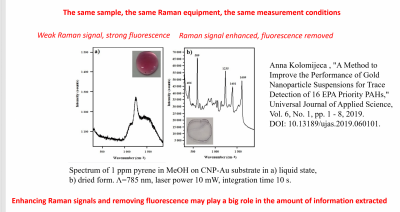- Home
- Anna Kolomijeca
Dr. Anna Kolomijeca |
|
|
Postdocs |
|
|
Group: |
Marine Environmental Technology and Deep-Sea Engineering |
|
Phone: |
|
|
Email: |
|
|
Room: |
1420, MARUM I |

About
I specialize in in-situ (optical, chemical) and remote sensing (RS) for water monitoring. I hold a PhD in Raman spectroscopy / TU-Berlin, one postdoc in applications of remote sensing / AU-Barcelona, one postdoc in microplastic (Raman sensing) / UofT-Canada, one postdoc in ocean methane / in situ mass spectrometry (and GC) Sorbonne-France, one postdoc in Raman ground water monitoring / CNRS-France and I am currently working as a postdoc in optical sensor development for deep ocean applications in MARUM-Bremen. My big passion is developing and implementing novel technological solutions for ocean health monitoring.
Research Interests
Currently I am looking for opportunities to develop and integrate Shifted Excitation Raman Difference Spectroscopy (SERDS) techniques on a marine platform for monitoring vulnerable eco systems in the deep ocean. Raman spectroscopy has various important advantages by being non-destructive, fast (seconds) and precise method for identifying chemical composition of the samples. In situ Raman sensor is of a great interest for deep ocean studies because biological and chemical samples will often change their chemistry once surfaced and other conventional techniques normally would require destruction of the sample as well as long processing times. However, Raman spectroscopy has two major limitations: weak signal and fluorescence (noise from the sample). I specialize in techniques which allow Raman signal enhancement (Surface enhanced Raman, SERS) and removing fluorescence (SERDS). Currently we are running pilot investigations for evaluating SERDS efficiency for marine biological samples (as biological samples usually cause the highest fluorescence). The next step will be building Raman/SERDS sensor for non-invasive monitoring of vulnerable eco systems in deep ocean (for example hydrothermal vents).

Some publications
A. Kolomijeca, L. Marx, S. Reynolds, T. Cariou1, E. Mawji, and C.Boulart. An update on dissolved methane distribution in the subtropical North Atlantic Ocean. Ocean Science, Vol 18 (5), pp. 1377–1388, 2022. DOI: 10.5194/os-18-1377-202.
A. Kolomijeca, J. Parrott, H. Khan, K. Shires, S. Clarence, C. Sullivan, L. Chibwe, D. Sinton, and C. M. Rochman. Increased Temperature and Turbulence Alter the Effects of Leachates from Tire Particles on Fathead Minnow (Pimephales promelas). Environmental Science and Technology, Vol 54 (3), pp.1750–1759, 2020. DOI: 10.1021/acs.est.9b05994.
A. Kolomijeca. A Method to Improve the Performance of Gold Nanoparticle Suspensions for Trace Detection of 16 EPA Priority PAHs. Universal Journal of Applied Science, Vol. 6(1), pp. 1 – 8, 2019. DOI: 10.13189/ujas.2019.06010.
A. Kolomijeca. Positioning technology applications related to environmental issues. Book chapter in “Multi Technology Positioning Professionals”, https://doi.org/10.1007/978-3-319-50427-8_ 2, Springer, 2017.
A. Kolomijeca. An autonomous sea going Raman/SERS instrument for in situ detection of chemicals in sea water. PhD thesis, TU Berlin 2013. Online: http://opus4.kobv.de/opus4-tuberlin/files/4153/kolomijeca_anna.pdf.
A. Kolomijeca, F. Roland, P. Leon, H. D. Kronfeldt. Autonomous in-situ Raman sensor, suitable for surface enhanced Raman spectroscopy (SERS) for detection of chemicals in the sea. Universal Journal of Applied Science, 1(2):38-43, 2013.


